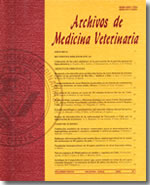Evaluation of the transmission and infectious capacity by direct contact with pigs experimentally inoculated with the Chilean isolate of the porcine reproductive and respiratory syndrome virus
Main Article Content
Abstract
The objective of this study was to determine the infectiousness and transmission capacity of the Chilean isolate of the PRRS virus to swine susceptible via direct contact. Therefore, 30 pigs, divided into 6 groups of 5 animals each, were used, one of which (G1) was inoculated with the virus and maintained in isolation unit 1 for 35 days, during which period blood samples were taken at 0, 3, 7, 11, 15, 19, 23, 27, 31 and 35 days post infection (dpi) for haemogram and viral isolation. Another group (G6) was used as a control and maintained in isolation unit 3. The remaining groups (G2, G3, G4, G5) were exposed by direct contact to the animals of G1 between 3 to 7, 10 to 14, 17 to 21, and 24 to 28 dpi, respectively, and later were taken to isolation unit 2 for 7 days. These animals were sampled for the viral isolate and haemograms at 0, 5 and 12 days post contact (dpc). At slaughter of G1 and G6 (35 dpi) and the contact groups (12 dpc) samples were collected from nasal mucous, tonsils, submandibular lymph node, lung and spleen for histopathological and immunohistochemical (IHC) study and samples of the tonsils and lungs for viral isolation. Only the pigs of G1 had a transitory fever and neither respiratory symptoms nor alterations in the haematological parameters were registered in the pigs of all groups. At necropsy, lymphadenopathy was observed in all the groups. Histopathologically, all the pigs of G1 had interstitial pneumonia, although via IHC few immunostained cells were detected. In lymphatic tissues, hyperplasia and lymphatic necrosis were observed. In all the pigs, cells positive to IHC were detected, especially in G3 and G4. The virus was isolated from blood between 3 and 23 dpi in G1, and between 5 and 12 dpc in G2 and G3; however it was not isolated from the serum of G4 and G5. The virus was isolated from the tonsils of all the pigs of G1 and the contact groups, although it was not isolated from the lungs in G4. These results indicate that the inoculated pigs are capable of transmitting the disease to susceptible pigs, including in the absence of viremia during a period of 28 days.

